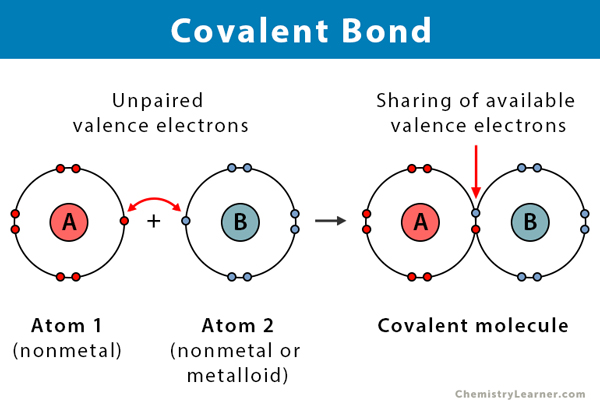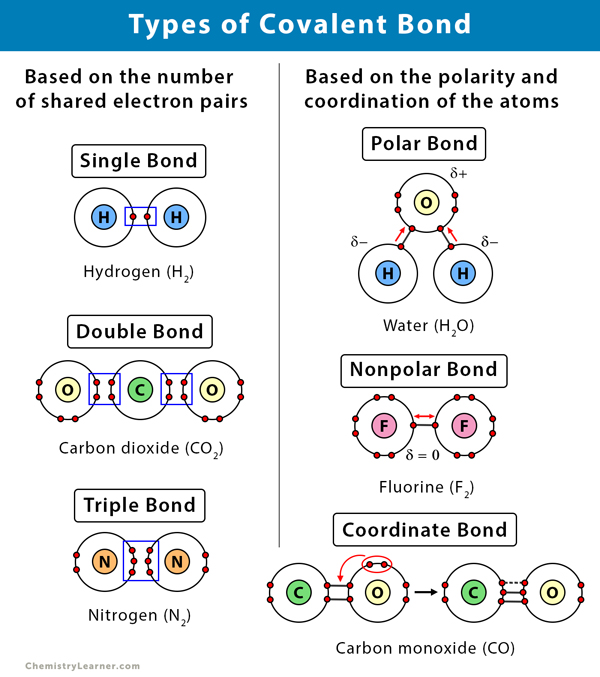Describe the Process of Covalent Bonding
Covalent bonds form when electrons are shared between atoms and are attracted by the nuclei of both atoms. Covalent bonding results in the formation of molecules or giant structures.

Covalent Bond Definition Types And Examples
Covalent bonding is the type of bonding between two atoms formed by mutual sharing of electrons and the molecules formed are known as covalent compounds.

. 1 day agoHydrogen bonding is the weakestBy Dr. The bond is created by the overlapping of two atomic orbitals 1. In polar covalent bonds the electrons are shared unequally as one atom exerts a stronger force of.
A covalent bond in chemistry is a chemical link between two atoms or ions in which the electron pairs are shared between them. For many molecules the sharing of electrons allows each atom to attain the. Describe how the covalent bond is formed as a result of electron sharing.
Discuss the conditions needed for covalent bonding and the stable molecule that is formed. Examples include CO NH4 and H3O. Covalent bonding occurs between atoms of non-metals.
Covalent bonds are the most important means of bonding in organic chemistry. Covalent bonding in simple words is the sharing of electrons between atoms to attain the noble gas configuration of the participating individual atoms. Conversely in order to break a chemical bond energy must be used - it is an endothermic process.
Project the image Covalent. Covalent bond in chemistry the interatomic linkage that results from the sharing of an electron pair between two atoms. It gains an electron by sharing one of the seven electrons from another fluorine atom to create a covalent bond.
The binding arises from the electrostatic attraction of their nuclei for the same electrons. In pure covalent bonds the electrons are shared equally. A covalent bond is a chemical bond that involves the sharing of electron pairs between atoms.
Covalent bonding is the bonding found in non metals involving the sharing of a pair of electrons or more between the atoms. In pure covalent bonds the electrons are shared equally. If atoms have an equal number of protons and electrons.
In polar covalent bonds the electrons are shared unequally as one atom exerts a stronger force of. Covalent Bonding Study Guide has everything you need to ace quizzes tests and essays. A covalent bond forms when the bonded atoms have a lower total energy than that of widely separated atoms.
There are therefore two shared electrons in the covalent bond one from each atom. Each fluorine atom in a diatomic fluorine molecule has a full octet consisting of seven electrons from its original set of electrons and the eighth electron shared with the other. In the process of covalent bonding electrons are shared between two or more atoms.
In pure covalent bonds the electrons are shared equally. Jan 12 2022 Unit 4 Chemical Bonding and Molecular Structure Valence electrons ionic bond and covalent bond Born Haber Cycle Polar character of covalent bond Covalent character of ionic bond Valance bond theory VSEPR theory Concept of hybridization involving sp and d orbitals Shapes of some. In this type of bond each shared electron will be counted toward both atoms valence shells for the purpose of.
All atoms in the periodic table when they bond are trying to achieve a full outer shell of 8 electrons so they are energetically stable. This type of bond may also be found in other chemical species such. Covalent bonding is the force of.
Covalent bonds form when electrons are shared between atoms and are attracted by the nuclei of both atoms. Covalent bonds form between two nonmetal atoms with identical or relatively close electronegativity values. It has the molecular formula of Cl 2.
The atoms in a covalent bond are held together by the electrostatic force of attraction. In pure covalent bonds the electrons are shared equally. By doing so the two chlorine atoms share one pair of electrons that bind them together called a single covalent bond as shown in Figure.
A covalent bond is a shared pair of electrons. Covalent bonds are formed between two atoms when both have similar tendencies to attract electrons to themselves ie when both atoms have identical or fairly similar ionization energies and electron affinities. Energy Levels Electrons and Covalent Bonding Show an animation to introduce the process of covalent bonding.
Covalent bonds form when electrons are shared between atoms and are attracted by the nuclei of both atoms. Each of these two chlorine atoms contributes one electron to each other for sharing. In this SparkNote we introduce several tools to describe covalent bonds which are formed when atoms share electrons in a mutual effort to attain full valence shells.
A covalent bond may also be termed a molecular bond. The most important representation that organic chemists use to depict covalently bonded molecules is the Lewis structure. The formation of a covalent bond is the result of atoms sharing some electrons.
These electron pairs are known as shared pairs or bonding pairs and the stable balance of attractive and repulsive forces between atoms when they share electrons is known as covalent bonding. In polar covalent bonds the electrons are shared unequally as one atom exerts a stronger force of. Dative covalent bonds are required.
This process is illustrated in Figure 3-4. In polar covalent bonds the electrons are shared unequally as one atom exerts a stronger force of. From a general summary to chapter summaries to explanations of famous quotes the SparkNotes Organic Chemistry.
Covalent bonds form when electrons are shared between atoms and are attracted by the nuclei of both atoms. Hence a covalent molecule with a single covalent bond is formed. If the atoms that form a covalent bond are identical as in H 2 Cl 2 and other diatomic molecules then the electrons in the bond must be shared equallyWe refer to this as a nonpolar covalent bondElectrons shared in nonpolar covalent bonds have an equal probability of being near each nucleus.

Covalent Bond Definition Properties Examples Facts Britannica



Comments
Post a Comment